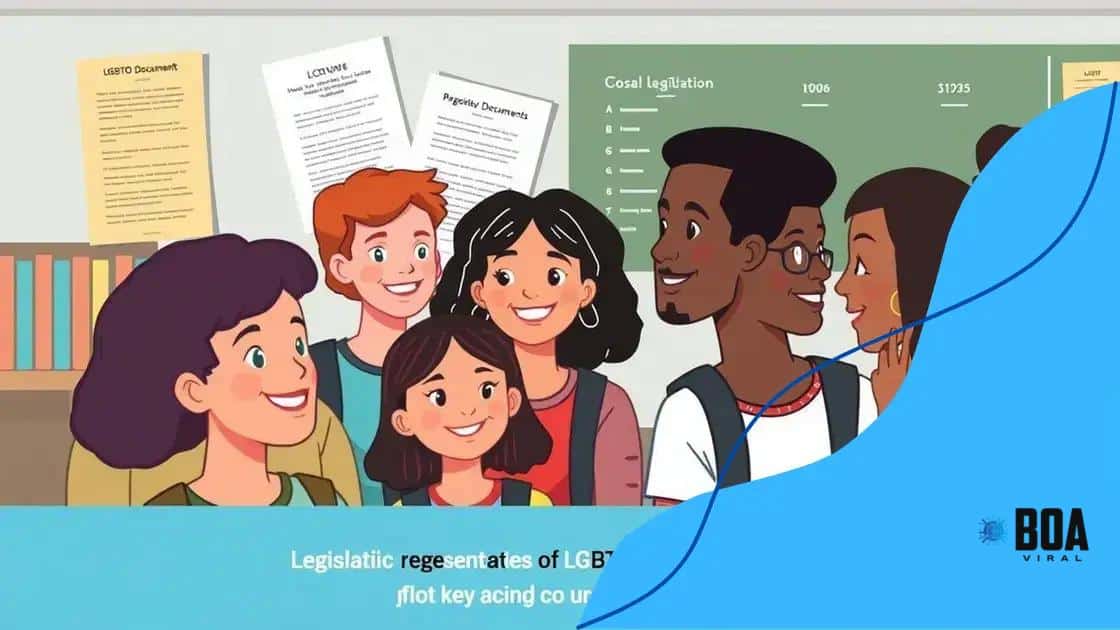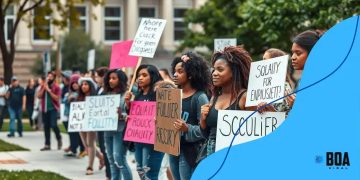LGBTQ+ protections in public education: are they enough?

LGBTQ+ protections in public education are essential for ensuring safe and inclusive environments where all students can learn without fear of discrimination or harassment.
LGBTQ+ protections in public education serve as a cornerstone for fostering a safe and inclusive environment for all students. Have you ever wondered how these protections truly impact everyday learning experiences? Let’s dive deeper into this vital topic.
Understanding LGBTQ+ Protections
Understanding LGBTQ+ protections is essential for creating inclusive educational environments. These protections are designed to ensure that all students, regardless of their sexual orientation or gender identity, can learn in a safe and supportive atmosphere.
Various laws and policies help safeguard LGBTQ+ rights in schools. For instance, Title IX, a federal law, prohibits sex-based discrimination and means that bullying or harassment related to sexual orientation is strictly not allowed. However, knowing how this law applies in real-world settings is vital for students and educators alike.
The Importance of LGBTQ+ Protections
It’s critical to recognize why these protections matter:
- Safety and Well-being: Students who feel safe are more likely to thrive academically.
- Equal Opportunities: Ensuring access to resources and support for LGBTQ+ students promotes equality.
- Positive School Environment: Inclusivity reduces bullying and fosters respect among peers.
Moreover, many states have their own regulations that provide additional support. Some schools implement policies that specifically address the needs of LGBTQ+ youth, like allowing the use of chosen names and pronouns. This helps students feel validated and accepted.
Implementing these protections not only benefits LGBTQ+ students, but also enriches the educational experience for everyone. It fosters a culture of respect and understanding. As discussions around LGBTQ+ rights continue to evolve, staying informed about these protections is crucial for students, families, and educators.
When schools take proactive steps to protect their students, it shows a commitment to diversity and inclusivity, making a difference in students’ lives. Everyone deserves a chance to succeed and learn free from discrimination.
Historical Context of LGBTQ+ Rights in Education
The historical context of LGBTQ+ rights in education reveals a landscape marked by struggle and progress. For many years, LGBTQ+ individuals faced challenges in accessing equitable education due to discrimination and stigma. Understanding this history is essential for recognizing the advancements made and the work still needed.
In the early 20th century, LGBTQ+ individuals were largely invisible in educational settings. It wasn’t until the mid-20th century that changes began to emerge, primarily driven by the civil rights movements. Activists fought fervently for equal rights, including in schools. The 1970s marked a pivotal point as more voices began to advocate for inclusion and acceptance.
Key Milestones in LGBTQ+ Education Rights
Several landmark events helped shape the educational landscape:
- Title IX (1972): This federal law prohibits sex discrimination in educational institutions, indirectly supporting LGBTQ+ rights by challenging institutionalized bias.
- The Stonewall Riots (1969): Widely seen as a catalyst for the LGBTQ+ rights movement, these riots ignited discussions about rights and representation in all areas, including education.
- The Formation of Advocacy Groups (1980s): Organizations like GLSEN (Gay, Lesbian & Straight Education Network) began advocating for safe schools policies, focusing on LGBTQ+ inclusivity.
- Same-Sex Marriage Legalization (2015): The Supreme Court ruling not only advanced marital rights but also reinforced the notion that schools must provide a welcoming environment for all.
Over time, policies began to develop to protect students from harassment and discrimination. In recent years, many states and school districts have implemented anti-bullying policies specifically addressing LGBTQ+ issues. These advancements have led to a more inclusive atmosphere, where students can thrive irrespective of their identity.
While significant progress has been made, challenges still exist. There are ongoing debates about the rights of LGBTQ+ students and the support they receive. Promoting awareness and understanding remains crucial for ensuring that all students feel safe and included in their educational journeys.
Key Legislation Affecting LGBTQ+ Students

Key legislation plays a critical role in shaping the rights of LGBTQ+ students in educational settings. These laws help protect against discrimination and ensure equal opportunities for all individuals, regardless of their sexual orientation or gender identity.
Among the most significant pieces of legislation is Title IX, established in 1972. This law prohibits sex discrimination in federally funded education programs and activities. It has been instrumental in addressing issues such as bullying and harassment based on sexual orientation within schools.
Impact of Title IX
Title IX has a broad impact, which includes:
- Protection Against Discrimination: LGBTQ+ students are shielded from discrimination in schools, promoting equal access to education.
- Support for Safe Environments: Schools are encouraged to create a safe atmosphere, free from bullying and harassment.
- Access to Resources: Students can access various resources, including counseling and support groups, which are vital for their well-being.
Another important development is the Matthew Shepard and James Byrd, Jr. Hate Crimes Prevention Act of 2009. This law expands federal hate crime laws to include those motivated by the victim’s sexual orientation or gender identity. It is a crucial step in addressing violence against LGBTQ+ individuals.
Additionally, many states have enacted their own laws to protect LGBTQ+ students. These laws often address issues like anti-bullying policies, allowing students to express their gender identity, and providing affirmative care in schools. However, the level of protection varies significantly from state to state, leading to a patchwork system.
Ongoing debates about the rights of LGBTQ+ students continue to shape the educational landscape. Understanding these key pieces of legislation is vital for educators, students, and families as they navigate the rights and protections available in schools.
Challenges Faced by LGBTQ+ Youth in Schools
Challenges faced by LGBTQ+ youth in schools can significantly impact their educational experiences and mental health. These challenges are often rooted in discrimination, bullying, and a lack of support, making it crucial to address these issues effectively.
Many LGBTQ+ students experience bullying based on their sexual orientation or gender identity. This bullying can take many forms, including verbal harassment, physical aggression, and social exclusion. Such negative experiences can lead to feelings of isolation and depression, which negatively affect academic performance.
Common Challenges
Some specific challenges that LGBTQ+ youth often encounter in schools include:
- Lack of Supportive Policies: Not all schools have policies that protect LGBTQ+ students, which can perpetuate discrimination and unsafe environments.
- Insufficient Resources: Many schools lack resources like counseling and support groups for LGBTQ+ students, leaving them without guidance.
- Stigmatization: Fear of being stigmatized can prevent students from expressing their true identities or seeking help when needed.
- Limited Awareness: Some educators and staff may not understand LGBTQ+ issues, which can result in a lack of support for students.
Moreover, LGBTQ+ students may also deal with mental health issues stemming from societal pressures and internal struggles. Many face anxiety and depression due to their experiences in school. It’s essential for schools to prioritize mental health resources and ensure that LGBTQ+ students know they have a safe space to talk about their experiences.
Additionally, the curriculum in many schools may not represent LGBTQ+ histories and experiences, which can make students feel unseen. Incorporating diverse narratives can help all students understand and respect the diversity of identities.
Addressing these challenges is vital for creating inclusive educational environments. Schools must recognize the unique struggles of LGBTQ+ youth and work toward creating safe, supportive spaces where all students can thrive.
Best Practices for Inclusivity in Education
Emphasizing best practices for inclusivity in education helps create a welcoming environment for all students, particularly LGBTQ+ youth. Implementing supportive strategies ensures everyone can thrive academically and socially.
One effective approach is to establish clear anti-bullying policies that specifically mention sexual orientation and gender identity. These policies create a safer atmosphere where students feel comfortable expressing themselves. Incorporating training programs for staff can significantly improve understanding and response strategies regarding LGBTQ+ issues.
Key Best Practices
Some of the best practices to foster inclusivity include:
- Inclusive Curriculum: Integrate LGBTQ+ history and contributions into the curriculum to help all students understand diverse perspectives.
- Safe Spaces: Designate safe spaces or clubs where LGBTQ+ students can gather, express themselves, and seek support.
- Gender-Neutral Facilities: Provide gender-neutral restrooms to allow all students to feel comfortable and safe during school hours.
- Open Communication: Encourage open dialogue between students, teachers, and parents about inclusivity, allowing for a better understanding of each individual’s needs.
Additionally, schools can organize events like Pride Month celebrations or LGBTQ+ awareness days. These events help foster respect and understanding among peers. Creating community partnerships with local LGBTQ+ organizations can also provide students with access to additional resources and support.
Furthermore, educators should continuously reflect on their language and practices. Using inclusive language when referring to students and their families can make a significant impact. This practice promotes respect and acknowledges the diverse identities present in the classroom.
Promoting inclusivity in education is essential for developing a supportive atmosphere for LGBTQ+ youth and their peers. By implementing these best practices, schools can create environments where all students feel valued and empowered.
FAQ – Questions about LGBTQ+ protections in public education
What are the key challenges faced by LGBTQ+ students in schools?
LGBTQ+ students often face bullying, lack of supportive resources, and insufficient representation in their curriculum, affecting their overall well-being.
How can schools promote inclusivity for LGBTQ+ youth?
Schools can promote inclusivity by implementing anti-bullying policies, training staff, creating safe spaces, and integrating LGBTQ+ topics into the curriculum.
What role does legislation play in supporting LGBTQ+ rights in education?
Legislation, such as Title IX, protects LGBTQ+ students from discrimination and harassment, helping to create safer educational environments.
Why is it important to have an inclusive curriculum?
An inclusive curriculum helps all students understand and respect diverse identities, fostering a sense of belonging among LGBTQ+ youth.






